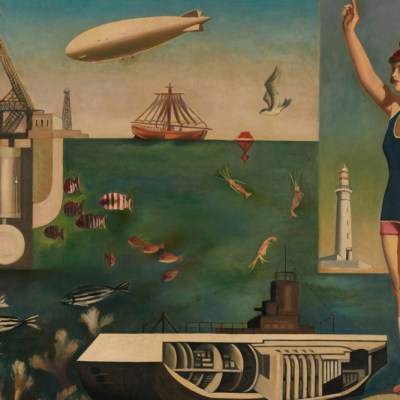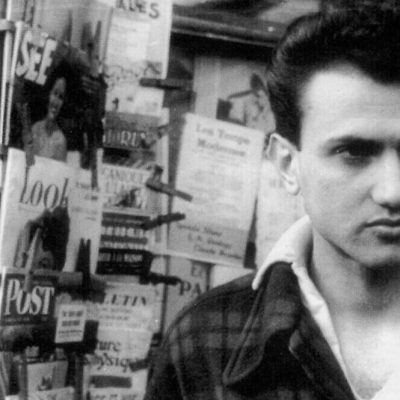The first survey of the Surrealist artist Victor Brauner (1903–66) in his homeland is the centrepiece of Timisoara’s European Capital of Culture 2023 programme. Held in the Muzeul National de Arta, an 18th-century baroque palace on Unity Square, ‘Inventions and Magic’ features around 70 of Brauner’s paintings, drawings, illustrations and letters, as well as two of his five sculptures, giving a comprehensive overview of his 40-year career.
Brauner spent much of that career in France, even representing his adoptive country at the Venice Biennale in 1966. Romanian politics were never amenable: he did not fit into the nationalistic wave that came with independence in 1918. Between 1925 and 1938 he lived at various times in Paris, where he befriended his compatriot Constantin Brancusi, André Breton and other Surrealists, and Bucharest. After Romania became an absolute monarchy in 1938 (military dictatorship was to come in 1940), Brauner left for good. He remained in France for the rest of his life, hiding from the Nazis (he was Jewish) during the war and ignoring threats of expulsion. Although he had joined the Romanian Communist Party in 1935, the post-war Socialist Republic plumped for Socialist Realism as its official style. Only 20 of his works, featured here, are now in the country, some in private collections.
Victor Brauner photographed by Man Ray in c. 1933. Collection Centre Pompidou, Paris, Musée national d’art moderne – Centre de création industrielle; © Centre Pompidou, MNAM-CCI/Dist. RMN-GP; © Man Ray Trust/Adagp, Paris

The retrospective is organised chronologically, showing how Brauner cycled through various avant-garde styles – cubism, Expressionism, Dada and constructivism – while in Bucharest. Some of these, painted around his first encounter with Surrealism, border on kitsch with their images of fire-breathing dragons, or a woman covered with snakes, but we find him on firmer ground in the form of playful postcard-sized drawings such as The Postman and especially Eyes in the Pockets (both c. 1929–30), which combines text with bovine imagery resembling that of Picasso. After officially joining the Surrealist movement in 1933 in Paris, Brauner established himself as one of its most important artists. Inspired by the writer Georges Bataille, Brauner produced a striking Self-Portrait (1931) in which one eye bled red (foreshadowing his loss of an eye in a fight in 1938). He was alert to the threat of fascism, painting two striking pieces influenced by George Grosz: he disfigured Hitler (1934) with militaristic nuts and bolts (and red eyes again) much as Grosz portrayed the German bourgeoisie as literally having heads full of shit. The Strange Case of Monsieur K. (1933) especially impressed Breton, with its tableaux of a Grosz-like father/dictator figure wearing suits or military uniforms, having sex, descending into grotesque lumps of fat.
Self-portrait (1931), Victor Brauner. Musée national d’art moderne – Centre de création industrielle; © Centre Pompidou, MNAM-CCI/Service de la documentation photographique du MNAM/Dist. RMN-GP; © Adagp, Paris

After returning to Romania in 1935, Brauner became part of a Surrealist circle there, working with the poets Gherasim Luca and Gellu Naum and producing paintings that were small enough to put in a suitcase if he had to suddenly leave. Stylistically, he moved closer to Dalí: Antithesis (1937) features an isolated eye staring out between a jumble of legs and faces; On the Pattern (1937) portrays a painter with brushes for eyes, in an aesthetic that anticipates Terry Gilliam’s animations for Monty Python’s Flying Circus.
During the war, Brauner struggled to paint, working instead with wax and experimenting in sculpture. His painting Stable unstable, plain of Théus (1942) recalls Leonora Carrington and Leonor Fini with its image of a naked sleepwalking woman whose hair transforms into a mystical animal. Letters and other archival material demonstrate how Brauner maintained his links to Romania, illustrating Naum’s first novel and corresponding with Luca. In Timisoara, a city with streets named after Romanian-born, French-based Dadaists Tristan Tzara and Marcel Janco, more might have been made of the wider modernist connection between Romania and France; Brauner was joined in his adoptive country by the poet Isidore Isou and playwright Eugène Ionesco, among others. (His friend and fellow expat Brancusi, who like Brauner was largely ignored in Romania in his lifetime, will be the subject of an exhibition in Timisoara in September.)
Stable unstable, plain of Théus (1942), Victor Brauner. Collection Centre Pompidou, Paris, Musée national d’art moderne – Centre de création industrielle; © Centre Pompidou, MNAM-CCI/Service de la documentation photographique du MNAM/Dist. RMN-GP; © Adagp, Paris

Brauner’s efforts to find ‘new directions’ for Surrealism in the post-war period, after the style had featured in advertising and Hollywood films, were not always successful. He worked in Henri Rousseau’s old studio and took on some of Rousseau’s Primitivism. Untitled (1952) and Deported (1956) are the weakest works here, the former showing a car powered by a flaccid cock and balls. The Rétractés series is far better. Brauner’s skeletal, half-human, half-robotic figures appear most impressively in Depolarisation of Intimacy II (1952), running away from each other in a dark, disembodied landscape. His final works – line drawings of animals with prominent eyes – recall the great paintings of the interwar period and round off an exhibition that powerfully highlights Romania’s significant contribution to the Surrealist movement.
On the pattern (1937), Victor Brauner. Collection Centre Pompidou, Paris, Musée nationale d’art moderne – Centre de création industrielle; © Adagp, Paris

‘Victor Brauner: Inventions and Magic’ is at the National Museum of Art, Timisoara, until 28 May.



